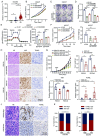Construction of exosome non-coding RNA feature for non-invasive, early detection of gastric cancer patients by machine learning: a multi-cohort study
- PMID: 39753334
- PMCID: PMC12229063
- DOI: 10.1136/gutjnl-2024-333522
Construction of exosome non-coding RNA feature for non-invasive, early detection of gastric cancer patients by machine learning: a multi-cohort study
Abstract
Background and objective: Gastric cancer (GC) remains a prevalent and preventable disease, yet accurate early diagnostic methods are lacking. Exosome non-coding RNAs (ncRNAs), a type of liquid biopsy, have emerged as promising diagnostic biomarkers for various tumours. This study aimed to identify a serum exosome ncRNA feature for enhancing GC diagnosis.
Designs: Serum exosomes from patients with GC (n=37) and healthy donors (n=20) were characterised using RNA sequencing, and potential biomarkers for GC were validated through quantitative reverse transcription PCR (qRT-PCR) in both serum exosomes and tissues. A combined diagnostic model was developed using LASSO-logistic regression based on a cohort of 518 GC patients and 460 healthy donors, and its diagnostic performance was evaluated via receiver operating characteristic curves.
Results: RNA sequencing identified 182 candidate biomarkers for GC, of which 31 were validated as potential biomarkers by qRT-PCR. The combined diagnostic score (cd-score), derived from the expression levels of four long ncRNAs (RP11.443C10.1, CTD-2339L15.3, LINC00567 and DiGeorge syndrome critical region gene (DGCR9)), was found to surpass commonly used biomarkers, such as carcinoembryonic antigen, carbohydrate antigen 19-9 (CA19-9) and CA72-4, in distinguishing GC patients from healthy donors across training, testing and external validation cohorts, with AUC values of 0.959, 0.942 and 0.949, respectively. Additionally, the cd-score could effectively identify GC patients with negative gastrointestinal tumour biomarkers and those in early-stage. Furthermore, molecular biological assays revealed that knockdown of DGCR9 inhibited GC tumour growth.
Conclusions: Our proposed serum exosome ncRNA feature provides a promising liquid biopsy approach for enhancing the early diagnosis of GC.
Keywords: GASTRIC CANCER; RNA EXPRESSION; TUMOUR MARKERS.
© Author(s) (or their employer(s)) 2025. Re-use permitted under CC BY-NC. No commercial re-use. See rights and permissions. Published by BMJ Group.
Conflict of interest statement
Competing interests: None declared.
Figures





Similar articles
-
Diagnostic efficacy of an extracellular vesicle-derived lncRNA-based liquid biopsy signature for the early detection of early-onset gastric cancer.Gut. 2025 Jul 7;74(8):1209-1218. doi: 10.1136/gutjnl-2024-333657. Gut. 2025. PMID: 40113244
-
Identification of blood-derived exosomal tumor RNA signatures as noninvasive diagnostic biomarkers for multi-cancer: a multi-phase, multi-center study.Mol Cancer. 2025 Mar 1;24(1):60. doi: 10.1186/s12943-025-02271-4. Mol Cancer. 2025. PMID: 40025576 Free PMC article.
-
Exosomal Liquid Biopsy for the Early Detection of Gastric Cancer: The DESTINEX Multicenter Study.JAMA Surg. 2025 Sep 1;160(9):973-982. doi: 10.1001/jamasurg.2025.2493. JAMA Surg. 2025. PMID: 40737022 Free PMC article.
-
Signs and symptoms to determine if a patient presenting in primary care or hospital outpatient settings has COVID-19.Cochrane Database Syst Rev. 2022 May 20;5(5):CD013665. doi: 10.1002/14651858.CD013665.pub3. Cochrane Database Syst Rev. 2022. PMID: 35593186 Free PMC article.
-
Cost-effectiveness of using prognostic information to select women with breast cancer for adjuvant systemic therapy.Health Technol Assess. 2006 Sep;10(34):iii-iv, ix-xi, 1-204. doi: 10.3310/hta10340. Health Technol Assess. 2006. PMID: 16959170
Cited by
-
Functions and Clinical Applications of Exosomes in Gastric Cancer.Int J Biol Sci. 2025 Feb 28;21(5):2330-2345. doi: 10.7150/ijbs.98087. eCollection 2025. Int J Biol Sci. 2025. PMID: 40083701 Free PMC article. Review.
-
Omics landscapes in molecular mechanisms with Amomum tsaoko as an example.Food Chem (Oxf). 2025 Aug 25;11:100294. doi: 10.1016/j.fochms.2025.100294. eCollection 2025 Dec. Food Chem (Oxf). 2025. PMID: 40933388 Free PMC article. Review.
-
Integration of Bulk and Single-Cell Transcriptomics Reveals BCL2L14 as a Novel IGKC+ T Cell-Associated Therapeutic Target in Breast Cancer.J Inflamm Res. 2025 Jun 5;18:7215-7234. doi: 10.2147/JIR.S523147. eCollection 2025. J Inflamm Res. 2025. PMID: 40491783 Free PMC article.
-
Multi-omics identification of a polyamine metabolism related signature for hepatocellular carcinoma and revealing tumor microenvironment characteristics.Front Immunol. 2025 Apr 22;16:1570378. doi: 10.3389/fimmu.2025.1570378. eCollection 2025. Front Immunol. 2025. PMID: 40330470 Free PMC article.
-
Exosomal long non-coding RNAs in human malignancies: biological functions and clinical applications.Med Oncol. 2025 Jun 24;42(8):279. doi: 10.1007/s12032-025-02845-8. Med Oncol. 2025. PMID: 40553231 Review.
References
-
- Janjigian YY, Shitara K, Moehler M, et al. First-line nivolumab plus chemotherapy versus chemotherapy alone for advanced gastric, gastro-oesophageal junction, and oesophageal adenocarcinoma (CheckMate 649): a randomised, open-label, phase 3 trial. Lancet. 2021;398:27–40. doi: 10.1016/S0140-6736(21)00797-2. - DOI - PMC - PubMed
MeSH terms
Substances
LinkOut - more resources
Full Text Sources
Medical
Miscellaneous
